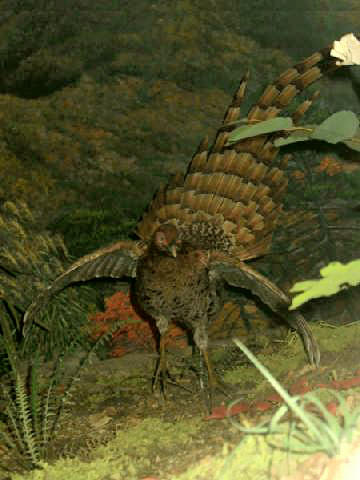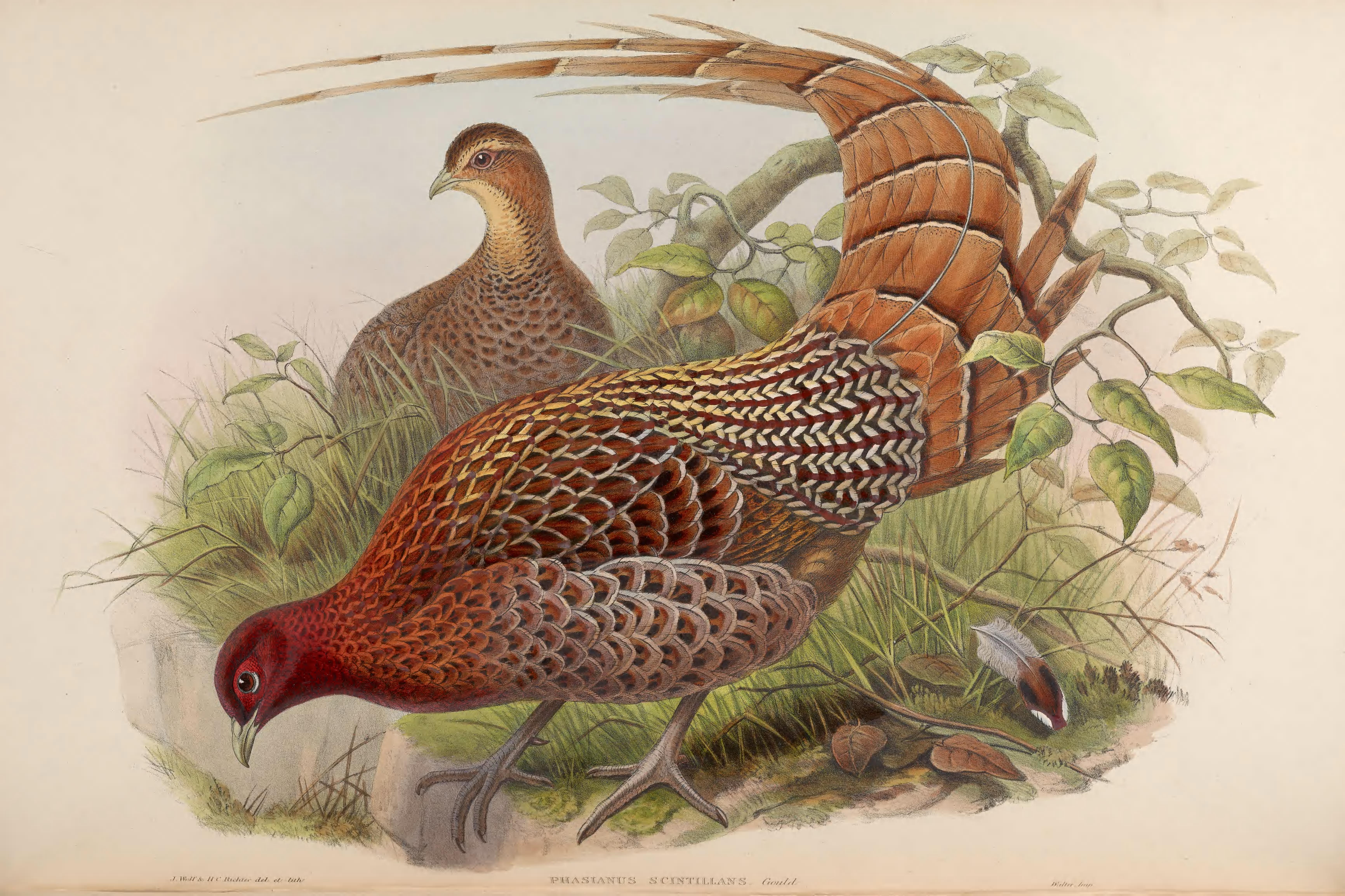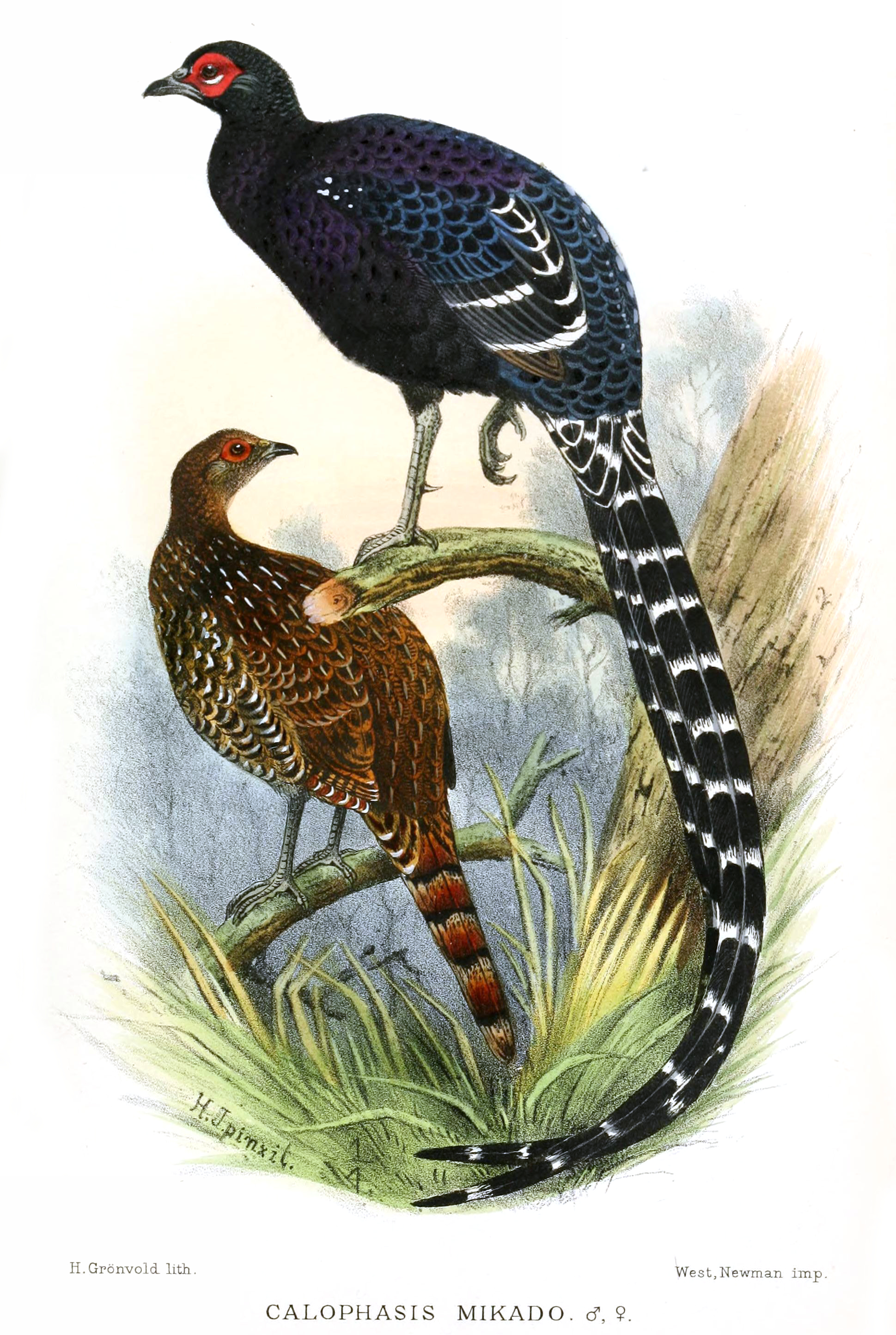|
Syrmaticus
__NOTOC__ The genus ''Syrmaticus'' contains the five species of long-tailed pheasants. The males have short spurs and usually red facial wattles, but otherwise differ wildly in appearance. The hens (females) and chicks of all the species have a rather conservative and plesiomorphic drab brown color pattern.Zhan & Zhang (2005) 5 species are generally accepted in this genus. Systematics and taxonomy The genus is occasionally included in ''Phasianus'' based on DNA sequence data, but this does not seem well warranted; the molecular evolution in this genus has been unusual and can easily mislead molecular phylogenetic studies and makes molecular clocks unreliable. At least in the cytochrome ''b'' sequence transitions have outnumbered transversions to an extent rarely seen in other birds. Transition-transversion frequencies in mtDNA control region are by contrast more like those usually seen in birds, but this region of the mitochondrial genome has been evolving unusually slowly ... [...More Info...] [...Related Items...] OR: [Wikipedia] [Google] [Baidu] |
Syrmaticus Reevesii
Reeves's pheasant (''Syrmaticus reevesii'') is a large pheasant within the genus ''Syrmaticus''. It is endemic to China. It is named after the British naturalist John Reeves, who first introduced live specimens to Europe in 1831. Description Males measure long and weigh . The male is brightly plumaged with a scaled golden white and red body plumage, grey legs, brown iris and bare red skin around the eye. The head is white with a black narrow band across its eyes. The male has an extremely long silvery white tail barred with chestnut brown. This pheasant is mentioned in the 2008 edition of ''Guinness World Records'' for having the longest natural tail feather of any bird species; a record formerly held by the crested argus pheasant. The tail can measure up to long. Females measure long and weigh . They are brown with a blackish crown, a buff face and greyish brown barred tail feathers. The females are about the same size as a male common pheasant. There are no known subspe ... [...More Info...] [...Related Items...] OR: [Wikipedia] [Google] [Baidu] |
Reeves's Pheasant
Reeves's pheasant (''Syrmaticus reevesii'') is a large pheasant within the genus ''Syrmaticus''. It is Endemism, endemic to China. It is named after the British people, British natural history, naturalist John Reeves (naturalist), John Reeves, who first introduced live specimens to Europe in 1831. Description Males measure long and weigh . The male is brightly plumaged with a scaled golden white and red body plumage, grey legs, brown Iris (anatomy), iris and bare red skin around the eye. The head is white with a black narrow band across its eyes. The male has an extremely long silvery white tail barred with chestnut brown. This pheasant is mentioned in the 2008 edition of ''Guinness World Records'' for having the longest natural tail feather of any bird species; a record formerly held by the crested argus, crested argus pheasant. The tail can measure up to long. Females measure long and weigh . They are brown with a blackish crown, a buff face and greyish brown barred tail fe ... [...More Info...] [...Related Items...] OR: [Wikipedia] [Google] [Baidu] |
Copper Pheasant
The copper pheasant (''Syrmaticus soemmerringii''), also known as Soemmerring's pheasant or , is a pheasant endemic to the Japanese archipelago. The scientific name commemorates the German scientist Samuel Thomas von Sömmerring. It is the official bird of multiple Japanese prefectures, cities, and towns. It was commonly hunted for sport throughout the 20th century. Its population has been in consistent decline since the 1970s due to factors including habitat destruction and predation, but the most widely cited cause is overhunting. Taxonomy The copper pheasant was described in 1830 by Coenraad Temmerick as ''Phasianus'' ''soemmerringii.'' It was named for the German scientist Samuel Thomas von Sömmerring, while the subspecies ''S. s. ijimae'' is named for Japanese zoologist Isao Ijima. It was reclassified into the ''Syrmaticus'' genus in 1914 by William Beebe, despite the differences between the males, because he saw a high number of similarities between females of the gen ... [...More Info...] [...Related Items...] OR: [Wikipedia] [Google] [Baidu] |
Elliot's Pheasant
Elliot's pheasant (''Syrmaticus ellioti'') is a large pheasant native to south-eastern China. Description Males are up to long; they are brown and white with a black throat, chestnut-brown upper parts, white belly, nape and wing bars, red bare facial skin and long rusty-barred whitish tail. Females are smaller, at long; they are rufous brown with a blackish throat, whitish belly and less barred tail. Distribution Elliot's pheasant is Endemism, endemic to south-eastern China (Guizhou, Hubei, Anhui, Zhejiang, Fujian, Jiangxi, Hunan, Guangxi and Guangdong provinces), where it lives in evergreen and mountain forests at altitudes of . Its diet consists mainly of seeds, leaves and berries. Behaviour and ecology Breeding Members of this breed are solitary animals, with the males especially being territorial. The courtship ritual involves males offering food and displaying. The average clutch size is between six and eight eggs. Eggs take a little under four weeks to hatch, while ju ... [...More Info...] [...Related Items...] OR: [Wikipedia] [Google] [Baidu] |
Mikado Pheasant
The Mikado pheasant (''Syrmaticus mikado'') is a species of gamebird in the pheasant family Phasianidae of the order Galliformes, gallinaceous birds. Sometimes considered an unofficial ''national bird'' of Taiwan (along with the Swinhoe's pheasant and Taiwan blue magpie), a pair of Mikado pheasants and Yushan National Park, one of the areas it is known to inhabit, is depicted in the 1000 dollar bill of the New Taiwan dollar. Distribution and habitat The Mikado pheasant is endemic to mountainous regions of Taiwan. The species occupies dense shrubs, bamboo growth and grassy terrain with conifer overstory in central and southern Taiwan, from 2000 to 3200 meters above sea level. Description With the tail included, males of this species get to be up to 70 cm in body length, while the smaller females measure up to 47 cm. The male is dark with plumage that refracts with blue or violet iridescence, with white stripes on its wings and tail. The female is brown and speckle ... [...More Info...] [...Related Items...] OR: [Wikipedia] [Google] [Baidu] |
Johann Georg Wagler
Johann Georg Wagler (28 March 1800 – 23 August 1832) was a German herpetologist and ornithologist. Wagler was assistant to Johann Baptist von Spix, and gave lectures in zoology at the Ludwig Maximilian University of Munich after it was moved to Munich. He worked on the extensive collections brought back from Brazil by Spix, and published partly together with him books on reptiles from Brazil. Wagler wrote ''Monographia Psittacorum'' (1832), which included the correct naming of the blue macaws. In 1832, Wagler died of an accidental self-inflicted gunshot wound while out collecting in München-Moosach. Life Johann Georg Wagler was a German naturalist and scientist in the 19th century, whose works primarily focused on herpetology and ornithology (Beolens, Watkins & Grayson, 2011). Johan Georg Wagler was born on 28 March 1800, in the city of Nuremberg, where the Chancellor of the City Court was Wagler's father (Wagler, 1884). After taking up gymnastics at Nuremberg, Johann Georg W ... [...More Info...] [...Related Items...] OR: [Wikipedia] [Google] [Baidu] |
Phylogeny
A phylogenetic tree or phylogeny is a graphical representation which shows the evolutionary history between a set of species or Taxon, taxa during a specific time.Felsenstein J. (2004). ''Inferring Phylogenies'' Sinauer Associates: Sunderland, MA. In other words, it is a branching diagram or a tree (graph theory), tree showing the evolutionary relationships among various biological species or other entities based upon similarities and differences in their physical or genetic characteristics. In evolutionary biology, all life on Earth is theoretically part of a single phylogenetic tree, indicating common ancestry. Phylogenetics is the study of phylogenetic trees. The main challenge is to find a phylogenetic tree representing optimal evolutionary ancestry between a set of species or taxa. computational phylogenetics, Computational phylogenetics (also phylogeny inference) focuses on the algorithms involved in finding optimal phylogenetic tree in the phylogenetic landscape. Phylogene ... [...More Info...] [...Related Items...] OR: [Wikipedia] [Google] [Baidu] |
Bird
Birds are a group of warm-blooded vertebrates constituting the class (biology), class Aves (), characterised by feathers, toothless beaked jaws, the Oviparity, laying of Eggshell, hard-shelled eggs, a high Metabolism, metabolic rate, a four-chambered heart, and a strong yet lightweight Bird skeleton, skeleton. Birds live worldwide and range in size from the bee hummingbird to the common ostrich. There are over 11,000 living species and they are split into 44 Order (biology), orders. More than half are passerine or "perching" birds. Birds have Bird wing, wings whose development varies according to species; the only known groups without wings are the extinct moa and elephant birds. Wings, which are modified forelimbs, gave birds the ability to fly, although further evolution has led to the Flightless bird, loss of flight in some birds, including ratites, penguins, and diverse endemism, endemic island species. The digestive and respiratory systems of birds are also uniquely a ... [...More Info...] [...Related Items...] OR: [Wikipedia] [Google] [Baidu] |
MtDNA
Mitochondrial DNA (mtDNA and mDNA) is the DNA located in the mitochondria organelles in a eukaryotic cell that converts chemical energy from food into adenosine triphosphate (ATP). Mitochondrial DNA is a small portion of the DNA contained in a eukaryotic cell; most of the DNA is in the cell nucleus, and, in plants and algae, the DNA also is found in plastids, such as chloroplasts. Mitochondrial DNA is responsible for coding of 13 essential subunits of the complex oxidative phosphorylation (OXPHOS) system which has a role in cellular energy conversion. Human mitochondrial DNA was the first significant part of the human genome to be sequenced. This sequencing revealed that human mtDNA has 16,569 base pairs and encodes 13 proteins. As in other vertebrates, the human mitochondrial genetic code differs slightly from nuclear DNA. Since animal mtDNA evolves faster than nuclear genetic markers, it represents a mainstay of phylogenetics and evolutionary biology. It also permits tra ... [...More Info...] [...Related Items...] OR: [Wikipedia] [Google] [Baidu] |
MtDNA Control Region
A mitochondrion is a specialized organelle found in the cytoplasm of eukaryotic cells, which is the powerhouse of cells that produce energy through oxidative phosphorylation. Besides producing energy, they are crucial for various cellular functions such as calcium signaling, controlling metabolism, synthesizing hemoglobin and steroids, and regulating programmed cell death. Besides the production of ATP, there is a complex relationship between the mitochondrial genome (mtDNA) and the nuclear genome (nDNA). Unlike nuclear DNA which resides in the nucleus, mtDNA is inherited from the mother. Upon fertilization, the mtDNA of the sperm is typically lost through ubiquitination, and only the egg contributes to the mtDNA of the zygote, due to the significant difference in mtDNA copy number between the sperm (about 100 copies) and the egg (about 100,000 copies). Mitochondrial DNA (mtDNA) Is a small, abundant, and purified molecule of DNA. It is a closed, circular, double-stranded molecu ... [...More Info...] [...Related Items...] OR: [Wikipedia] [Google] [Baidu] |
Sister Species
In phylogenetics, a sister group or sister taxon, also called an adelphotaxon, comprises the closest relative(s) of another given unit in an evolutionary tree. Definition The expression is most easily illustrated by a cladogram: Taxon A and taxon B are sister groups to each other. Taxa A and B, together with any other extant or extinct descendants of their most recent common ancestor (MRCA), form a monophyletic group, the clade AB. Clade AB and taxon C are also sister groups. Taxa A, B, and C, together with all other descendants of their MRCA form the clade ABC. The whole clade ABC is itself a subtree of a larger tree which offers yet more sister group relationships, both among the leaves and among larger, more deeply rooted clades. The tree structure shown connects through its root to the rest of the universal tree of life. In cladistic standards, taxa A, B, and C may represent specimens, species, genera, or any other taxonomic units. If A and B are at the same taxonomic ... [...More Info...] [...Related Items...] OR: [Wikipedia] [Google] [Baidu] |
Eumelanin
Melanin (; ) is a family of biomolecules organized as oligomers or polymers, which among other functions provide the pigments of many organisms. Melanin pigments are produced in a specialized group of cells known as melanocytes. There are five basic types of melanin: eumelanin, pheomelanin, neuromelanin, allomelanin and pyomelanin. Melanin is produced through a multistage chemical process known as melanogenesis, where the oxidation of the amino acid tyrosine is followed by polymerization. Pheomelanin is a cysteinated form containing poly benzothiazine portions that are largely responsible for the red or yellow tint given to some skin or hair colors. Neuromelanin is found in the brain. Research has been undertaken to investigate its efficacy in treating neurodegenerative disorders such as Parkinson's. Allomelanin and pyomelanin are two types of nitrogen-free melanin. The phenotypic color variation observed in the epidermis and hair of mammals is primarily determine ... [...More Info...] [...Related Items...] OR: [Wikipedia] [Google] [Baidu] |







